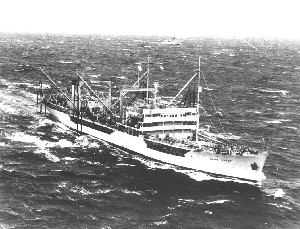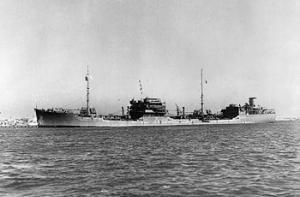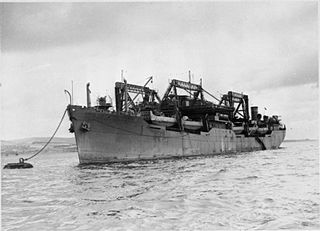
RFA Wave King (A182) was a Wave-class fleet support tanker of the Royal Fleet Auxiliary built at Govan by Harland & Wolff Ltd. In 1945, she served in the Far East with the British Pacific Fleet, designated Task Force 57 upon joining the United States fleet. On 6 May 1945 Wave King and Wave Monarch were with the Logistic Support Group 300 miles south-east of Miyako to refuel Task Force 57 which was launching air strikes against island targets in the Okinawa campaign.

RFA Wave Chief was a Wave-class fleet support tanker of the Royal Fleet Auxiliary that was built in 1946 as SS Empire Edgehil by Harland & Wolff, Govan, Glasgow, United Kingdom.

RFA Cedardale (A380) was a Dale-class fleet tanker of the Royal Fleet Auxiliary. She was originally one of two ships which were purchased by the British Admiralty from the Anglo Saxon Petroleum Co for evaluation purposes. Cedardale was decommissioned on 15 November 1959 and laid up at Hong Kong.
RFA Derwentdale (A114) was a Dale-class fleet tanker and landing ship (gantry) of the Royal Fleet Auxiliary. She served during the Second World War.

RFA Dingledale (A144) was a Dale-class fleet tanker of the Royal Fleet Auxiliary. She was first based at Gibraltar, and served as escort oiler on several Malta Convoys. During Operation Pedestal, together with RFA Brown Ranger, she fuelled one cruiser and 24 destroyers in 14 hours. Narrowly escaping damage during a severe air raid in Bône in December 1942, she survived to join the Pacific Fleet Train, and was present for the Japanese surrender in Tokyo Bay. After the war, she carried out routine freighting duties. She was decommissioned on 10 May 1959, and was laid up at Devonport.

RFA Abbeydale (A109) was a fleet tanker of the Royal Fleet Auxiliary and was originally one of six ships ordered by the British Tanker Co which were purchased on the stocks by the Admiralty. She was built by Swan Hunter and Wigham Richardson Ltd and launched on 28 December 1936. Abbeydale served until being decommissioned on 18 September 1959 and laid up at HMNB Devonport. She was then sold for scrapping, arriving at the Thos. W. Ward breakers' yards at Barrow-in-Furness on 4 September 1960.

RFA Bishopdale (A128) was a Dale-class fleet tanker of the Royal Fleet Auxiliary.

RFA Broomdale (A168) was a Dale-class fleet tanker of the Royal Fleet Auxiliary. She spent much of her career in the Indian Ocean and Far East.

HMAS Supply was a Tide-class replenishment oiler of the Royal Fleet Auxiliary (RFA) and the Royal Australian Navy (RAN). Originally named Tide Austral and intended to be the first ship of a post-World War II Royal Australian Fleet Auxiliary, manpower and financial shortages meant that when the Belfast-built ship was launched in 1955, she could not be accepted into Australian service. Instead, she was loaned to the RFA, operating RFA Tide Austral (A99). In August 1962, the ship was commissioned directly into the RAN, then renamed a month later to HMAS Supply. Supply operated as part of the RAN until her decommissioning at the end of 1985.

HMS Andromeda was a Leander-class frigate of the Royal Navy. She was built at HM Dockyard Portsmouth. She was launched on 24 May 1967 and commissioned into the Royal Navy on 2 December 1968. She took part in the Falklands War. She was sold to India in 1995, for use as a training ship, being renamed INS Krishna. She was finally decommissioned in May 2012.

The Fort Victoria or Fort II class is a class of replenishment oiler of the Royal Fleet Auxiliary, a role that combines the missions of a tanker and stores supply ship. As such they are designated auxiliary oiler replenisher (AOR). They are tasked with providing ammunition, fuel, food and other supplies to Royal Navy vessels around the world. There were two ships in the class, Fort Victoria and Fort George; the latter being taken out of service and despatched for scrapping at a Turkish breakers as a consequence of budgetary cutbacks.

RFA Ennerdale (A173) was a Dale-class fleet tanker and landing ship (gantry) of the Royal Fleet Auxiliary.

The Wave class was a class of replenishment oilers built for service supporting the Royal Navy during the later years of the Second World War. They were subsequently transferred to the Royal Fleet Auxiliary after the end of the war, and went on to support British and allied fleet units in Cold War conflicts such as the Korean War.
The Dale class consisted of three tankers chartered for service for the Royal Fleet Auxiliary in 1967. They served for a number of years supporting Royal Navy and allied fleet operations, during which one, Ennerdale, was lost. The remaining two were returned to their original owners in the mid-1970s.
The Sprite class were a class of spirit tankers that served with the Royal Fleet Auxiliary, supporting the Royal Navy during the Second World War. They went on to support British and allied fleet units during the Cold War.

The Surf class were a class of replenishment oilers taken up for service with the Royal Fleet Auxiliary (RFA), supporting the Royal Navy during the Korean War. Two were commercial tankers under construction in British yards as the war began. A third ship was captured from in the Far East and brought into the RFA as Surf Pilot. She was never utilised however, and was laid up until being scrapped in 1960. The remaining two tankers were laid up at about this time, and were either sold or scrapped by 1970.

The bombing of RFA Fort Victoria took place on 6 September 1990, when a unit of the Provisional Irish Republican Army (IRA) planted two bombs aboard the Royal Fleet Auxiliary replenishment ship at Harland and Wolff shipyard in Belfast, Northern Ireland, where the vessel had been launched four months before. One of them exploded in the engine room, causing flooding and serious damage. The second device didn't explode and was defused several days later. The attack resulted in a two-year delay before Fort Victoria became fully operational.
RFA Darkdale was a Dale-class fleet tanker of the Royal Fleet Auxiliary (RFA), launched on 23 July 1940 as Empire Oil, completed in November 1940 and transferred to the RFA as Darkdale. She was sunk during the Second World War on 22 October 1941 by the German submarine U-68. Her wreck in James Bay off Jamestown, Saint Helena continued to leak oil, posing a potential environmental threat to the coastal waters of Saint Helena, until Ministry of Defence divers drained the ship's tanks in 2015.

HMS Springbok was an R-class destroyer which served with the Royal Navy during World War I. The R class were an improvement on the preceding M-class, including using geared steam turbines. Launched on 9 March 1917, the vessel operated as part of the Harwich Force on escort duties. In 1917, the destroyer, along with sister ship Thruster, captured the German merchant ships Brietzig and Pellworm. After the conflict, the destroyer initially was posted to the navy's torpedo school but was soon afterwards reduced to reserve. After less than ten years in service, Springbok was sold on 16 December 1926 and broken up.















